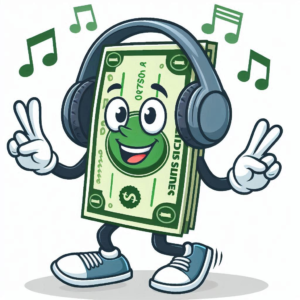
Your complete guide to finally adult-ing and building that emergency fund you’ve been ghosting since forever
Look, we need to talk about that emergency fund you’ve been avoiding like that friend who’s really into cryptocurrency. You know, the one who keeps trying to convince you that some coin with a dog meme is “definitely going to the moon.”But unlike crypto, emergency funds aren’t just another financial fad that’ll disappear faster than your motivation to keep that New Year’s resolution. They’re the real MVP of your financial game plan, even if they’re about as exciting as watching paint dry.
TL;DR (Because I Know You’re Scrolling)
- Your emergency fund should cover 3-6 months of expenses (yes, including your Netflix subscription)
- Start with a baby emergency fund of $1,000 (it’s like training wheels for your financial bicycle)
- Automate your savings because your willpower has the attention span of a goldfish
- Keep it liquid (that means easily accessible, not actually wet)
- Choose high-yield savings accounts (because your money should work harder than you do)
Why Your Empty Emergency Fund is Basically Playing Russian Roulette with Your Future
Let’s get real for a second: life has a twisted sense of humor. It’s like Murphy’s Law is running a stand-up comedy show where you’re the unwitting participant. Your car decides to die the same week your phone takes a swimming lesson in the toilet, and suddenly you’re considering whether selling a kidney on the black market is really that bad of an idea.
The “It Won’t Happen to Me” Syndrome
You know what’s funny? We all think we’re immune to financial emergencies, like we’ve got some invisible force field protecting us from life’s monetary meteorites. Spoiler alert: we don’t. And those meteorites? They’re coming in hot.
Here’s a fun fact: according to a recent survey, 56% of Americans couldn’t cover a $1,000 emergency expense without going into debt. That’s like playing financial Jenga with blocks made of Jell-O – it’s gonna collapse eventually.
The Emergency Fund Math That’ll Make Your Brain Hurt (But Your Wallet Happy)

Step 1: Figure Out Your Monthly Expenses (The Real Ones)
Time for some honest math (yes, that’s a thing). Write down everything you spend money on monthly:
- Rent/Mortgage (your overpriced shoebox)
- Utilities (because apparently, electricity isn’t free)
- Food (including those 2 AM takeout orders)
- Transportation (your car payment or public transit pass)
- Insurance (because adulting)
- Phone bill (for doom-scrolling purposes)
- Streaming services (all 27 of them)
- Other essentials (yes, coffee counts)
Step 2: Multiply That by 3-6
This is your emergency fund target. If your monthly expenses are $3,000, you’re looking at $9,000-$18,000. I’ll wait while you pick your jaw up off the floor.
The “But I’m Broke AF” Starter Pack
The Baby Steps Approach (Because Nobody Runs Before They Crawl)
- Start with $1,000
- It’s not enough for a full-blown emergency, but it’ll handle most of life’s “surprise parties”
- Think of it as your financial training wheels
- Yes, this means cutting back on some things (farewell, daily artisanal coffee)
- The Automated Savings Game
- Set up automatic transfers because your willpower is about as reliable as public WiFi
- Even $25 per paycheck adds up (that’s like, what, five fancy coffees?)
- Make it happen the day after payday (before you convince yourself you need another houseplant)
The “Finding Money in Your Budget” Magic Trick

Time to play detective in your own spending habits. Here’s where to look:
- Subscription services you forgot about (looking at you, gym membership)
- Food delivery apps (your convenience is costing you big time)
- Impulse purchases (those 3 AM Amazon shopping sprees)
- “Just this once” expenses that happen weekly
Where to Stash Your Emergency Cash (Hint: Not Under Your Mattress)
High-Yield Savings Accounts: The Least Boring Option
Look for:
- No monthly fees (because paying to save money is like paying to breathe)
- Easy access (but not too easy – we don’t want drunk you buying another air fryer)
- FDIC insurance (because trust issues are healthy when it comes to money)
- Decent interest rates (make your money work like it owes you rent)
The “But What About Investment Returns?” Trap
I see you eyeing that stock market like it’s the last slice of pizza. Stop it. Your emergency fund isn’t meant to make you rich; it’s meant to keep you from becoming poor(er). Keep it simple, accessible, and boring.
The Psychology of Actually Keeping Money Saved (It’s Harder Than It Looks)
The “Future You” Mindset
Think of your emergency fund as sending care packages to future you. Future you will either:
- Be really grateful for past you’s financial wisdom
- Be really mad at past you for buying that third Nintendo Switch instead of saving
The “But It’s Just Sitting There” Syndrome
Yes, your emergency fund is just sitting there, like a responsible adult at a party. That’s literally its job. It’s not supposed to be the life of the party; it’s supposed to be the designated driver.
Common Emergency Fund Killers (And How to Avoid Them)
- The “This Totally Counts as an Emergency” Trap
- A sale at your favorite store is not an emergency
- Your friend’s destination wedding is not an emergency
- That limited edition whatever is not an emergency
- If it’s not threatening your survival or ability to work, it’s probably not an emergency
- The “I’ll Replace It Next Month” Lie
- This is like saying you’ll start your diet tomorrow
- Next month you’ll have next month’s expenses to deal with
- Just don’t do it
The Emergency Fund Success Stories That’ll Make You Feel Bad (In a Motivational Way)
Meet Sarah: The Reformed Financial Disaster
Sarah used to think emergency funds were for people who had their lives together (you know, the ones who meal prep and actually fold their laundry). Then her car died, her pet needed surgery, and her laptop crashed – all in the same month. After maxing out her credit cards and eating ramen for six months to pay them off, she got serious about her emergency fund.
Now she has six months of expenses saved and sleeps better at night. She still doesn’t fold her laundry though, because we can’t all be perfect.
The “But What If…” Section (Because Your Brain Loves to Overthink)
Q: “What if I need more than I’ve saved?” A: That’s what insurance is for. Your emergency fund isn’t supposed to rebuild your house after a hurricane; it’s supposed to cover your deductible and keep you fed while you figure things out.
Q: “What if I never need it?” A: Congratulations! You’ve won at life. Maybe buy a lottery ticket because clearly, you’re the luckiest person alive.
Q: “What if inflation eats my savings?” A: Inflation eating your savings is better than having no savings for inflation to eat.
The Action Plan (Because Reading Without Doing is Just Procrastination)
- This Week:
- Calculate your monthly expenses (all of them)
- Open a high-yield savings account
- Set up an automatic transfer (even if it’s tiny)
- This Month:
- Cut one unnecessary expense
- Redirect that money to your emergency fund
- Tell your friends about your new financial goals (peer pressure works both ways)
- This Year:
- Hit your $1,000 baby emergency fund
- Start working toward 3-6 months of expenses
- Become the person your dog thinks you are
The Bottom Line (Because All Good Things Must End)
Building an emergency fund is like flossing: everyone knows they should do it, few people actually do, and those who don’t usually regret it later. Don’t be the person who wishes they had started sooner. Future you will either thank you or curse you – the choice is yours. Remember: The best time to start an emergency fund was yesterday. The second best time is now. The worst time is after you actually need it.
Now go forth and save like your financial life depends on it (because it kind of does).
